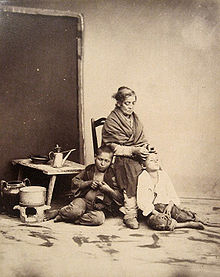
Nitpicking
Encyclopedia

Louse
Lice is the common name for over 3,000 species of wingless insects of the order Phthiraptera; three of which are classified as human disease agents...
s (the eggs of lice, generally head lice) from the host's hair
Hair
Hair is a filamentous biomaterial, that grows from follicles found in the dermis. Found exclusively in mammals, hair is one of the defining characteristics of the mammalian class....
. As the nits are cemented to individual hairs, they cannot be removed with most lice combs
Comb
A comb is a toothed device used in hair care for straightening and cleaning hair or other fibres. Combs are among the oldest tools found by archaeologists...
and, before modern chemical methods were invented, the only options were to shave all the host's hair or to pick them free one by one.
This is a slow and laborious process, as the root of each individual hair must be examined for infestation. It was largely abandoned as modern chemical methods became available; however, as lice populations can and do develop resistance
Antibiotic resistance
Antibiotic resistance is a type of drug resistance where a microorganism is able to survive exposure to an antibiotic. While a spontaneous or induced genetic mutation in bacteria may confer resistance to antimicrobial drugs, genes that confer resistance can be transferred between bacteria in a...
, manual nitpicking is still often necessary.
As nitpicking inherently requires fastidious, meticulous attention to detail, the term has become appropriated to describe the practice of meticulously searching for minor, even trivial errors in detail (often referred to as "nits" as well), and then criticising them (see nitpicking (pastime)
Nitpicking (pastime)
Nitpicking is the pastime of pointing out minor flaws or mistakes. The term is often used in a negative light. The term comes from the intense concentration and careful attention to detail required when nitpicking .- Film and television :Some nitpickers specialize in finding mistakes in movies and...
).

